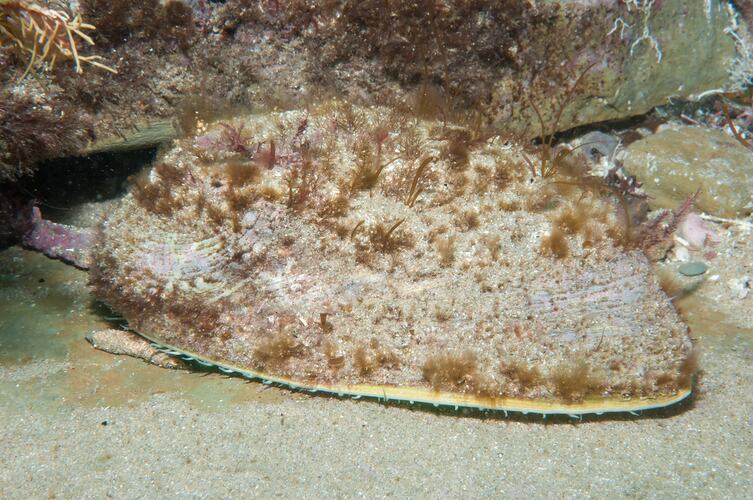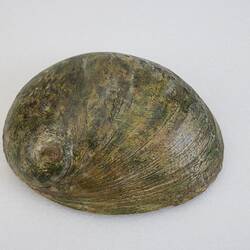General Description
The Green-lipped Abalone is the largest Abalone species in Australian waters. Shell a smooth flattened oval, green or faintly red. Row of perforations around the edge of the shell; flat to the shell surface without a raised edge, 7-8. Tentacles along the edge of the foot; edge of foot and tentacles green. Shell up to 23 cm long.
Biology
Abalone use the holes in their shells to move water into their shells and over their gills, allowing them to breathe. They cling to the surface of rocks using their very large foot muscle. Abalone feed on algae in the water and on rocks and also graze on seagrass. They do not move very far, remaining near one spot. Abalone reproduce by broadcast spawning, releasing eggs and sperm into the water. The Green-lipped Abalone spawns between spring and late summer. Their strong foot and low shell profile makes them able to live in quite rough water, but the Green-lipped Abalone usually prefers more sheltered areas. It is thought to live to around 15 years old. Abalone species are fished for food all over the world. In Australia there are strict controls on how much, what size, and when abalone can be recreationally fished. These restrictions vary between states.
Distribution
South-eastern mainland Australia and Tasmania.
Habitat
Crevices and under boulders on rocky reefs in calm to rough water, up to 40 m depth.
More Information
-
Animal Type
-
Animal SubType
-
Brief Id
Light coloured smooth oval shell, row of round holes at edge, green tentacles and edge of foot.
-
Colours
Green, Brown, Black, Grey
-
Maximum Size
13 cm
-
Habitats
-
Diet
Herbivore
-
Diet Categories
Algae
-
Endemicity
-
Commercial
Yes
-
Conservation Statuses
CITES: Not listed, FFG Threatened List: Not listed, DSE Advisory List: Not listed, IUCN Red List: Vulnerable
-
Depths
Shore (0-1 m), Shallow (1-30 m)
-
Water Column Locations
On or near seafloor
-
Taxon Name
-
Scientific Author
Donovan, 1808
-
Common Name
Green-lipped Abalone
-
Phylum
-
Subphylum
-
Superclass
-
Class
-
Subclass
-
Order
-
Superfamily
-
Family
-
Genus
-
Species Name
laevigata


